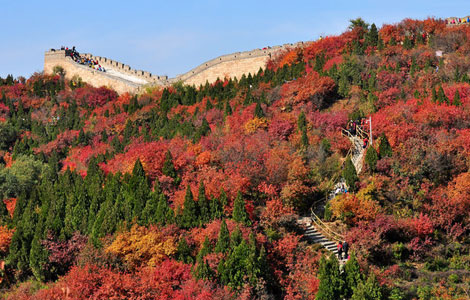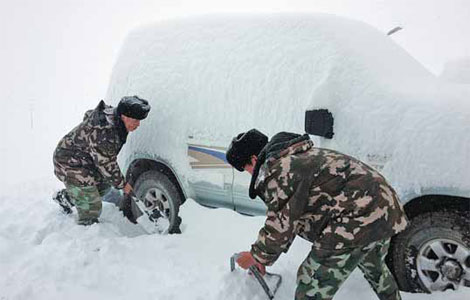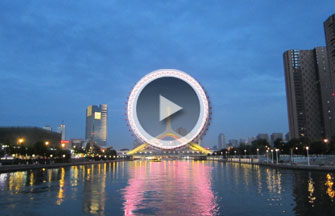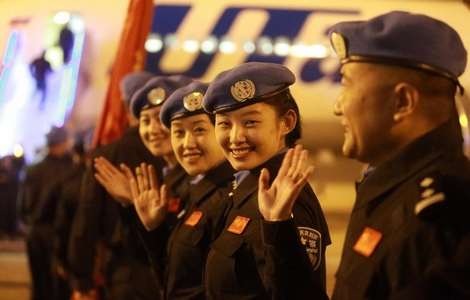Full Text: Development and Progress of Tibet
Updated: 2013-10-22 13:17
(Xinhua)
|
|||||||||
III. Political Progress--the People Are the Masters of Their Own Fate
Democratic reform and regional ethnic autonomy lifted Tibet out of the old state of feudal serfdom under theocracy and put in place the systems of people's congress and regional ethnic autonomy, under which people of all ethnic groups in Tibet have become the true masters of the country, society and their own fate. With the development and improvement of socialist democracy around the country, Tibet has seen its democratic system growing sounder, forms of democracy becoming more diversified, and channels for orderly political participation being expanded.
Establishing the system of people's congresses
The system of people's congress is a fundamental political system of China that ensures the people's right to be the masters of the country. Under this system the Chinese people exercise state power through the National People's Congress (NPC) and local people's congresses at different levels. In September 1965 the First Session of the First People's Congress of the Tibet autonomous region was held in Lhasa, marking the formal establishment of this system in Tibet. Tibet's administrative, judicial and procuratorial organs are all created by the regional people's congress to which they are responsible and by which they are supervised. Major regional affairs are decided by the regional people's congress. Tibet's administrative organs carry out the laws, regulations, rules, resolutions and decisions adopted by the regional people's congress. Through deputies to the people's congress at different levels, people in Tibet exercise their right to manage state and regional affairs. All Chinese citizens living in Tibet who are 18 years old or above, regardless of gender, occupation, family background, ethnicity, religious belief, educational background, financial conditions or length of residence in this region, enjoy the right to vote and the right to be elected. People of all ethnic groups in Tibet directly elect deputies to the people's congresses at the county (district) and township (town) levels, and these deputies then elect deputies to the regional people' s congress and to the NPC. The Moinba and Lhoba ethnic groups, despite their small populations, both have their representatives at the NPC and local people' s congresses at all levels in Tibet. During elections at the regional, prefecture (city), county (district) and village (town) levels, the voter turnout rate has grown steadily over the years. In the 2012 elections at these four levels the voter turnout rate exceeded 94 percent.
Deputies of Tibetan and other ethnic minorities make up the overwhelming majority in the local people' s congresses at all levels. In 2012, among the 34,244 deputies elected directly and indirectly at these four levels, 31,901 were from the Tibetan, Moinba, Lhoba, Naxi, Hui, Zhuang and other ethnic minorities, accounting for more than 93 percent. Among the present NPC deputies, 20 are from the Tibet autonomous region, of whom 12 are from the Tibetan ethnic group, one each from the Moinba and Lhoba ethnic groups. Among the 44 members of the standing committee of the tenth regional people's congress, 25 are from the Tibetan and other ethnic minorities; among the 14 chairpersons and vice-chairpersons of the standing committee, eight are from the Tibetan and other ethnic minorities. Women have also seen their social status raised markedly. Female deputies make up 25.4 percent of the total to the Tibet regional people' s congress, while women make up 34.49 percent of all civil servants in governments at all levels.
Establishing the political consultation system
The system of multi-party cooperation and political consultation is a basic political system of China, and socialist consultative democracy is an important form of people's democracy in China. On December 20, 1959 the First Session of the First Tibet Autonomous Regional Committee of the Chinese People's Political Consultative Conference (CPPCC) was held in Lhasa, marking the creation of this Committee. It also marked the establishment in Tibet of the system of multi-party cooperation and political consultation under the leadership of the Communist Party of China (CPC), a system that ensures that all the people in Tibet, from all strata and all circles, can fully voice their opinions and play their roles in political life. The CPC Committee and People's Government of the Tibet autonomous region have incorporated political consultation into their decision-making procedure, conducting extensive consultation to solicit the local people's opinions on major issues in social and economic development and concrete problems concerning the people's interests. The CPPCC Tibet committee members come from all circles and all ethnic groups, and are elected on an extensive basis to represent their respective circles or ethnic groups. Uniting all people's societies and people from all ethnic groups and all circles, they diligently perform their duties in political consultation, democratic supervision, and participation in the deliberation and administration of state affairs, and make suggestions based on in-depth investigations or research; as an important driving force for Tibet, they are making great contributions to economic development and social progress in the autonomous region. At present, Tibet has 29 members on the CPPCC National Committee, including 26 from the Tibetan and other ethnic minorities. From 2008 to 2012 the Tenth Tibet Autonomous Regional Committee of the CPPCC received 1,507 proposals and has replied to them all.
Implementing the system of regional ethnic autonomy
To carry out regional ethnic autonomy in areas where ethnic minorities live in compact communities is a basic political system of China, and also a basic policy to handle problems concerning ethnic minorities in China. All ethnic groups in Tibet enjoy all the political rights prescribed in the Constitution of the People's Republic of China and other laws. In addition, they enjoy political rights specially drawn up for ethnic autonomous regions. According to the Constitution and the Law on Regional Ethnic Autonomy, the Tibet autonomous region enjoys extensive rights of autonomy, including legislative power, flexible enforcement of relevant state laws, right to use the spoken and written languages of the ethnic minorities, right of personnel management, right of fiscal management, and right to independently develop culture and education.
Since the Tibet autonomous region was set up in 1965, the regional people's congress and its standing committee have made over 290 local laws and regulations, or resolutions and decisions of a legislative nature, and formulated measures for the flexible implementation of some state laws in Tibet in order to suit local conditions. For example, Tibet made alternative regulations in 1981 and 2004, in which the legally marriageable ages for men and women were both reduced by two years from what was prescribed in the Marriage Law of the People's Republic of China, and polyandrous and polygynous relations that had existed before the regulations took effect would be allowed to continue if no one involved proposes dissolution of the marriage. Another example is that in addition to the national holidays, Tibet has other public holidays, mostly traditional Tibetan festivals such as the Tibetan New Year and Shoton Festival. In the contingent of local officials, 70.53 percent are from the Tibetan and other ethnic minorities, and among county and township leaders, 73.03 percent are from the Tibetan and other ethnic minorities. Since the Tibet autonomous region was set up, all the chairpersons of the standing committee of the regional people' s congress and of the regional people' s government have been elected from the Tibetan ethnic group. The system of regional ethnic autonomy ensures that political, economic, social and cultural rights of the people of all ethnic groups in Tibet are effectively protected.
Expanding community-level democracy in both urban and rural Tibet
In China community-level democracy is an effective way of ensuring that the people are masters of their own country, and an important way of expanding the political participation of China's citizens. After years of exploration, Tibet has put in place a system of community-level democracy covering both farming and pastoral areas with Chinese and Tibetan characteristics. In Tibet, the villagers' self-governance system and the system of regional ethnic autonomy have helped institutionalize and regulate community-level democracy, guaranteed the people's rights to participate in and discuss state and regional affairs, and aroused their enthusiasm for political participation. On July 5, 1959 a total of 443 peasants of Khesum Village in the Shannan region founded the first association of peasants in Tibet, starting the building of community-level democracy in Tibet. In 1993 Tibet published the Measures for the Tibetan Autonomous Region' s Implementation of the Law of Organizing the Villagers' Committees of the People's Republic of China (For Trial Implementation), ensuring that the election of villagers' committees around the region is conducted according to due procedures. Currently, over 95 percent of the villages in Tibet have established the system of villagers' representative meetings. A democratic management system mainly consisting of village regulations, code of conduct for villagers and self-governance rules, as well as a democratic supervision system that requires village affairs be made known to all villagers are being improved. All villages now make village affairs public and exercise democratic management; and over 90 percent of the villages in Tibet have set up billboards, ensuring the ordinary people's rights to be informed, to participate, to decide and to supervise. During the seventh general election of village (community) committees of Tibet, 1,686,800 people registered, and 1,495,000 voted, making a turnout rate of 88.7 percent; and 26,335 were elected to village or community committees. Community-level democracy has been improving. Tibet's 192 urban communities have all set up community residents' congresses and community committees, providing a solid organizational guarantee for the self-governance of local residents.
Establishing and cementing a new ethnic relationship
In the Tibet autonomous region there are over 40 ethnic groups, including those of the Tibetan, Han, Hui, Moinba, Lhoba, Naxi, Sherpa and Deng, with the Tibetan group making up the majority of the population. During the long history of Tibet, these peoples jointly developed the Tibetan Plateau and created the history of Tibet, making it an important part of the history of the Chinese nation. After the People's Republic of China was founded in 1949, the Central Government carried out an ethnic policy that stresses ethnic equality and unity, regional ethnic autonomy and the common prosperity of all ethnic groups. For over 60 years since its peaceful liberation, Tibet has fully carried out the state ethnic policy, removing political, economic and social factors that would have resulted in ethnic inequality, while eliminating the class differences and personal bondage relations peculiar to Tibet; thus, it has established a new socialist ethnic relationship featuring equality, unity, mutual-aid and harmony.
Driven by the growing socialist market economy, population movements have become more and more frequent between Tibet and the rest of China, between the Tibetan group and other ethnic groups, and within Tibet; mutual exchanges, tolerance and fusion between ethnic groups has become the mainstream of the ethnic relationship. While people of all ethnic groups go to Tibet for business, work, exchanges, pilgrimages and tourism, numerous Tibetan people leave Tibet and the Tibetan-inhabited areas in Sichuan, Yunnan, Gansu and Qinghai provinces, and go to inland cities for business, work, study, exchanges and tourism. The China Tibetology Research Center conducted a research in 2011 to study the migration of Tibetan population in inland China. It found that there are different numbers of Tibetan people, floating or resident, in Beijing, Shanghai, Chengdu, Guangzhou, Xining, Lanzhou, Kunming and other big cities. For example, in the city proper of Chengdu there is a Tibetan population of over 30,000 with registered permanent residence, and 150,000 to 200,000 without registered permanent residence. In addition, areas where Tibetans live in compact communities have appeared in some of the counties and urban districts of Chengdu. The People's Government of the Tibet autonomous region has worked hard to educate local people about ethnic unity. It holds a theme campaign every September to increase awareness of ethnic unity. Every year there is a conference for the commendations of those who have been outstanding in promoting ethnic unity and progress. Many other activities are also organized by the government to promote this theme.
 Teacher killed, two wounded in Nevada middle school shooting
Teacher killed, two wounded in Nevada middle school shooting
 Smog wraps northeast, schools forced to close
Smog wraps northeast, schools forced to close
 Architect looks to the big picture
Architect looks to the big picture
 Teachers, students divided over Gaokao reform plan
Teachers, students divided over Gaokao reform plan
 Dogfight looms over jets
Dogfight looms over jets
 Peak season for fall foliage in Beijing
Peak season for fall foliage in Beijing
 Train carrying carrying oil, gas derails in Canada
Train carrying carrying oil, gas derails in Canada
 30,000 turn out in Beijing Marathon
30,000 turn out in Beijing Marathon
Most Viewed
Editor's Picks

|

|

|

|

|

|
Today's Top News
Building a bridge of hearts in the heartland of the US
Li-Medvedev meeting to boost cooperation
China issues white paper on Tibet's development
Hollywood must think bigger about China
Nation witnesses launch of luxury rental businesses
Obama vows to get healthcare website fixed
US OKs Alibaba structure
Economy to see 'good ending' in Q4
US Weekly

|

|








